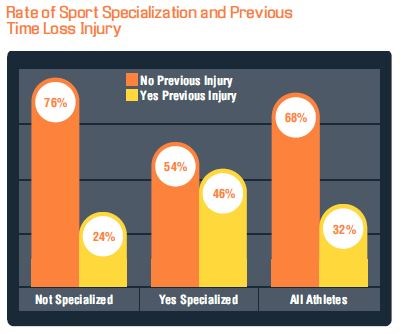More Sports, Less Injuries
When one athlete focuses soley on one sport, their injury likelyhood is higher and they are more susceptible to an injury.
More stories from Rilee Schreiner
Growing up being an athlete, players are always told that if they want to play at the collegiate level, they have to focus solely on that sport, but one wrong turn, one wrong swing, one wrong slide, one wrong play, can take the dream of college sports away.
Most adults tell young athletes is that if they are involved in too many sports, they will get themselves injured. Surprisingly this isn’t the case. Studies show that specialized athletes are more likely to get hurt than multi-sport athletes.
A 2017 study from the University of Wisconsin found that high school athletes with “a high specialization classification” had an 85 percent higher amount of injuries of lower extremities than high school athletes with a “low specialization classification”. Athletes who play more than one sport are less likely to get involved in accidents.
“Overuse injuries occur when an athlete repeats the same motion over and over again,” NCSA Director of Softball Jaimie Duffek said. “Playing multiple sports gives athletes time to heal and develop different muscle groups, tendons and ligaments.”
This explains why athletes who participate in multiple sports have less injuries. They use multiple muscle groups in each sport they play which when they are in other sports, it gives the last muscle group time to heal while keeping the others fresh. Although athletes would benefit from playing multiple sports, there are things athletes and parents can do to help a specialized athlete avoid season ending injuries.
“Children involved in early specialization, or who participate in more hours of sports per week than their age, should be monitored closely for signs of burnout, overuse injuries, or potential decrements in performance from overtraining,” orthopedic surgeon J. Pieter Hommen said. “Furthermore, their training should incorporate an integrative neuromuscular training program that focuses on periodic strength and conditioning training to develop diverse motor skills.”
Neuromuscular training is a program that focuses on training nerves and muscles to react and communicate. This program is designed to prevent ACL injuries, which is most common in young athletes. It also strengthens the knee which also strengthens all the lower extremities. This works with muscles most athletes won’t use, but those muscles have a huge part in helping players perform at their highest levels. When people got to the professional leagues, the states are alarming. A study by The American Journal of Sports Medicine proves the disadvantages of single sport athletes.
“It looked at 237 professional athletes in the NBA and compared those who were specializing in a single sport by high school versus those who spent high school playing a variety of sports. 36 were multi-sport athletes; 201 were single sport,” MD Caitlin Rugg said. “The 37 who did not specialize in high school played in an average 78.4 percent of games, v. 72.8 percent for single sport athletes. The multi-sport athletes were also less likely to sustain a major injury; 25 percent had one as opposed to 43 percent of single sport. Interestingly, 94 percent of multi-sport athletes were still active in the league, as opposed to 81.1 percent of the single sport ones.”
To get to be great at one sport doesn’t mean an athlete has to focus and prioritize that sport. A big part of being amazing at one sport comes from other sports. There are simply more benefits for an athlete when being involved in more sports rather than specializing in one.

